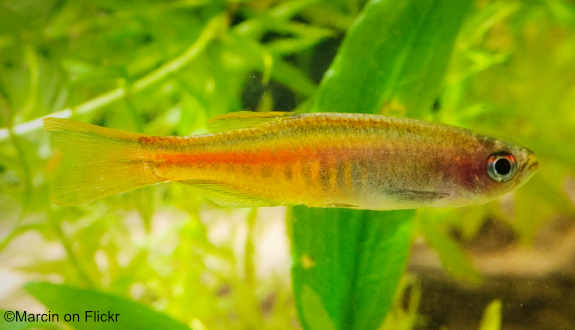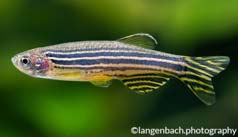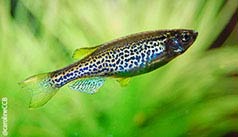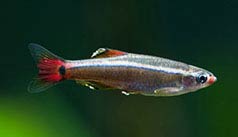

Alternative species (click on the thumbnail to see the card)
Names
Scientific name
Danio albolineatus
Brachydanio albolineata
Nuria albolineata
Danio stoliczkae
Danio pulcher
Danio tweediei
Common name
Pearl danio
Origin

Origin: Sumatra, Thailand, Malaysia
Biotope: Asian
Dimorphism

The male is slender, more colorful and a little larger than the female / He often has a red spot on the belly
Group

Cyprinidae
Volume

120 L / 26 Imp gal / 32 US gal
Parameters

T°: 18 to 25°C or 64 to 77°F
pH: 6.7 to 7
Hardness: 5 to 12°dGH
Difficulty

Easy
Size

6 to 7cm (2.4 to 3.2")
Longevity

2 to 3 years
Living zone
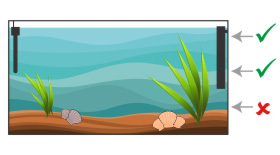
Top and middle
Individuals

10
Food
How to feed the Leopard danio?
Food
How to feed the Leopard danio?
This omnivorous fish does not present any difficulty as for its food. It accepts freeze-dried food of good quality. However, supplement as often as possible with live or frozen prey, such as artemia, daphnia, mosquito larvae, kril, mud worms, mysis...
It has a preference for drosophila (small flies). This meal drives them crazy!
Complete with a vegetable part in the form of spirulina or chopped spinach, or with flakes for vegetarian fish.
Behavior
What kind of behavior does the Leopard danio have?
Behavior
What kind of behavior does the Leopard danio have?
This fish is peaceful, sociable and very active. Because of this, it lives in shoal in the upper part of the aquarium. It is a dynamic swimmer that swims zigzagging among the plants.
Cohabitation
Who can live with the Leopard danio?
Cohabitation
Who can live with the Leopard danio?
The first rule to follow in terms of cohabitation is obviously the presence of several specimens. A group starts to feel comfortable with 10 Danios (with more females than males, a ratio of 1 male for 3 females seems to give a stable balance to the group), but the more they are numerous, the better!
As for the other species, no particular problem since they are completely ignored.
Breeding
How to breed the Leopard danio?
Breeding
How to breed the Leopard danio?
Quite easy. Recommended water parameters are a temperature of 22°C or 72°F, a ph of 7 and a hardness of 5 to 10°dGH. The aquarium should be dimly lit but will still benefit from the morning sunshine.
Prepare the spawning by isolating a female in an aquarium of about 30 liters / 6 Imp Gal / 8 US Gal (it must be very planted, for example with Java moss). Leave it for a few days and then introduce the male. If spawning does not take place, add another male (note that once a pair is formed, it is for life!). After spawning, remove the parents as soon as possible because they will eat the eggs.
Egg laying consists of between 500 and 600 eggs. Count 36 to 48 hours of incubation. After hatching, free swimming occurs after 5 to 7 days. The fry grow very quickly.
Fry feeding: infusers, rotifers then nauplias of artemia or cyclops.
Its aquarium
Which aquarium for the Leopard danio?
Its aquarium
Which aquarium for the Leopard danio?
In nature, the Pearl danio is found in the clear waters of rivers and streams. To reproduce these conditions, keep this fish in water around 22/23°C or 72/73°F, if possible rich enough in oxygen (so no heating is needed). Similarly, the Danio pearl prefers new water to aged water: change the water in your aquarium very regularly (25 to 30% of the volume per week). As far as the filter is concerned, this fish likes a light current: opt for a flow rate of 1 or 2 times the volume per hour.
Plant densely and use floating plants (Ceratopteris for example) to shade the aquarium. However, be sure to leave enough room for the fish to swim freely. Dark soil (e.g. pozzolana) will make your fish feel safe and bring out their color. Finally, install peat bog roots, a few large pebbles, bamboo stems or large stones to recreate a scree.
Finally, remember to cover the aquarium well because the Danio is an excellent jumper!
Good To know
Find all additional information!
Good To know
Find all additional information!
Very sturdy and easy to maintain, this fish is ideal to start in aquarium.
There is a variant of ochre/yellow color: the "Danio Yellow".
Yours photos!
Comments
Sort by:
Please login to post comments
